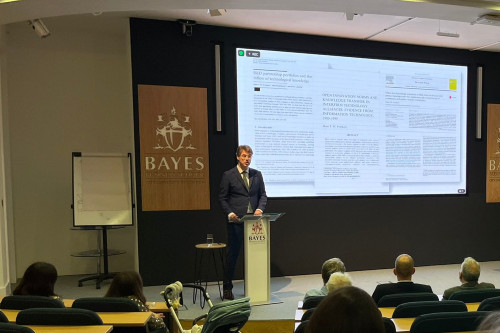By Chris Mahony (Senior Communications Officer), Published
Workers adjust how they compete against colleagues for promotion or pay rises depending on how their organisation is performing against rivals, research by a professor from Bayes Business School (formerly Cass) suggests.
Professor Hans Frankort, Professor of Strategy at Bayes, and colleagues analysed the number of “overtakes” performed by motorcycle riders competing in MotoGP from 2004 to 2020. They assessed how the riders’ approach to overtaking was shaped by the competitive threats and opportunities facing their team – and the resources available to the teams it was challenging or threatened by. The data revealed how often riders sought to overtake both teammates (internal overtakes) and riders from other teams (external overtakes).
Applying the data to industry
Professor Frankort said: “Sports – particularly motorsports – can be a good proxy for several other industries as they are extremely competitive: if you don’t perform and progress you may be out. Workers in sectors such as consultancy and financial services face similar pressures.”
The paper, which was published in the Academy of Management Journal, found that riders systematically adjusted their internal and external overtakes based on their team’s competitive threats and opportunities, as well as the resources available to those competitor teams.
Professor Frankort continued: “Earlier research has shown that employees compete to improve their relative standing in the eyes of their employer, in the hope of climbing the career ladder. Such behaviours may include poaching colleagues’ clients or even disrupting or sabotaging their work. This study suggests that ambitious workers tend to modify those behaviours when the standing of their organisation is about to deteriorate or improve. Why? Because they see the standing of their firm as an important factor in deciding who to compete with to advance their career.
“If the company has a chance to out-perform better-resourced rivals, employees’ workplace behaviour is geared towards being seen to be a key contributor to that success. For example, a salesperson might try to poach colleagues’ clients. However, if a firm is facing threats, such as losing market share to smaller rivals, workers may feel that infighting is poor form. Instead, they would focus on competing against rival firms. Inside the firm, individuals may simply want to blend into the background when their company is going through difficult times.”
The findings suggest, Professor Frankort said, that employers can influence the nature of their employees’ competitive actions. For example, employers could highlight threats to the firm from underdog firms or its opportunities against bigger rivals.
The research also found that riders’ overtaking attempts were shaped by their contractual position with the team. For example, replacement riders – the MotoGP equivalent of agency workers – attempt more overtakes against teammates when the team is doing well and against all riders when the team is struggling.
The paper concludes: “It may be that replacement riders are keen to signal their skills relative to incumbents, hoping to secure a permanent contract.”
Riders whose contracts will not be renewed challenge their teammates on the track and are less likely to overtake riders from other teams – suggesting they feel detached from the team and even disgruntled with it.
These findings, Professor Frankort noted, give a rare insight into how employees on various kinds of contracts behave.
The other authors of the paper, Revving up or backing down? Cross-level effects of firm-level tournaments on employees’ competitive actions, are Patrick Hallila from Imperial College London and Professor Paolo Aversa from King’s College London.


